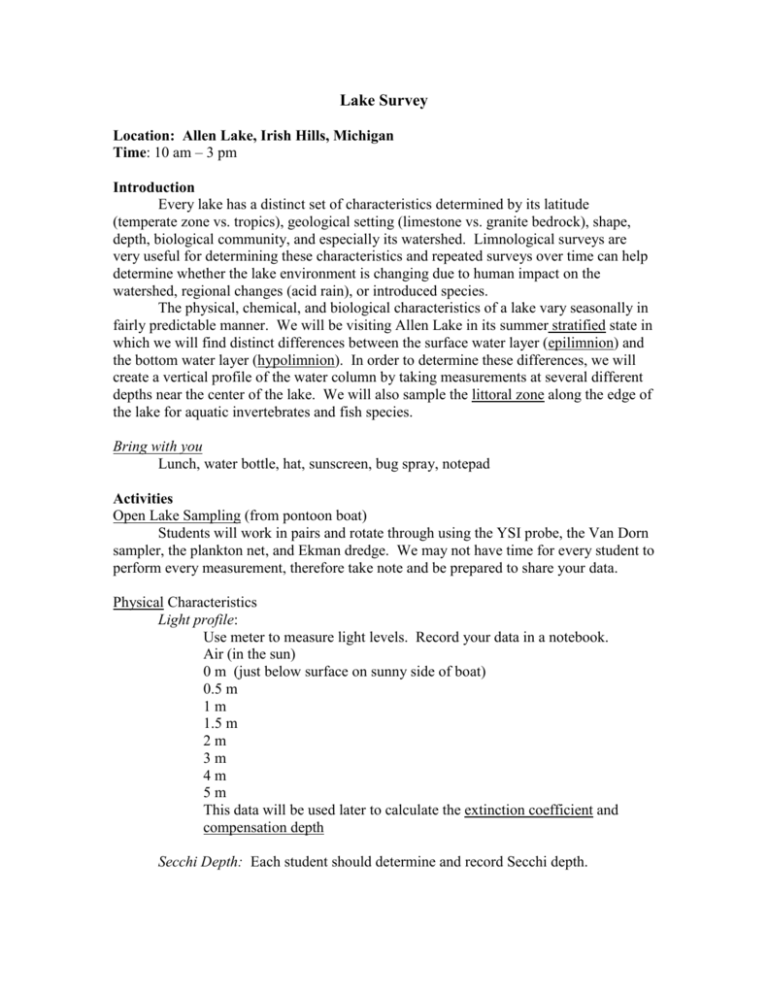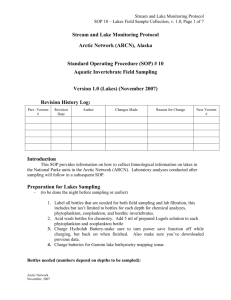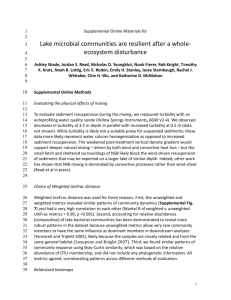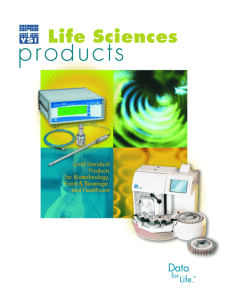Lake Survey
advertisement

Lake Survey Location: Allen Lake, Irish Hills, Michigan Time: 10 am – 3 pm Introduction Every lake has a distinct set of characteristics determined by its latitude (temperate zone vs. tropics), geological setting (limestone vs. granite bedrock), shape, depth, biological community, and especially its watershed. Limnological surveys are very useful for determining these characteristics and repeated surveys over time can help determine whether the lake environment is changing due to human impact on the watershed, regional changes (acid rain), or introduced species. The physical, chemical, and biological characteristics of a lake vary seasonally in fairly predictable manner. We will be visiting Allen Lake in its summer stratified state in which we will find distinct differences between the surface water layer (epilimnion) and the bottom water layer (hypolimnion). In order to determine these differences, we will create a vertical profile of the water column by taking measurements at several different depths near the center of the lake. We will also sample the littoral zone along the edge of the lake for aquatic invertebrates and fish species. Bring with you Lunch, water bottle, hat, sunscreen, bug spray, notepad Activities Open Lake Sampling (from pontoon boat) Students will work in pairs and rotate through using the YSI probe, the Van Dorn sampler, the plankton net, and Ekman dredge. We may not have time for every student to perform every measurement, therefore take note and be prepared to share your data. Physical Characteristics Light profile: Use meter to measure light levels. Record your data in a notebook. Air (in the sun) 0 m (just below surface on sunny side of boat) 0.5 m 1m 1.5 m 2m 3m 4m 5m This data will be used later to calculate the extinction coefficient and compensation depth Secchi Depth: Each student should determine and record Secchi depth. Temperature and Turbidity: This data will be collected using the YSI multiprobe. The hand unit stores the data, which will be provided to you later as an Excel file. Using the YSI, record data just below the surface, at 1 m and continue at increments of 2 meters all the way to the bottom or until you run out of cable. *If the cable does not reach the bottom, how can you obtain data from deeper depths? Chemical Characteristics *Dissolved Oxygen (mg/L) *Conductivity (uS) *pH *Total Dissolved Solids *in situ chlorophyll fluorescence *These measurements are recorded on the YSI. Total Phosphorus Alkalinity These measurements require water samples. Use the Van Dorn sampler to collect water samples at 1m depth and at a depth in the hypolimnion about 2 m above the bottom. Label and fill 1 L sample bottles and put these samples on ice. Samples will be kept frozen until analysis at a later date. Biological Characteristics Zooplankton If the zooplankton net is equipped with a flow meter, first record the meter reading. Then lower the net to about 2 meters above the bottom and then pull it to the surface at a rate of about 1 ft per second. Record depth of tow and flow Rinse the net with a rinse bottle and concentrate the contents in the mesh cup. Preserve zooplankton in formalin for later analysis. The zooplankton net collects from a given depth to the surface. How could you use the net to determine differences in zooplankton between the hypolimnion and the epilimnion? Phytoplankton Use the YSI measurements to determine the depth where in situ chlorophyll fluorescence is greatest. Use the Van Dorn bottle to collect a water sample from this depth. Pour sample into a 125 ml dark plastic bottle and add 1.25 ml of Lugol’s Solution as preservative. Benthos Collect 4 “grab” samples using the Ekman dredge: 2 from the bottom in a shallow area of the Lake where dissolved oxygen is high (how would you determine oxygen?) and 2 samples from near the center of the lake. Set the spring on the Ekman dredge (USE CAUTION!) and lower it to the bottom. Trigger dredge with a messenger and pull to surface. Empty dredge into a sieve bucket and strain sediments for benthic invertebrates. Preserve invertebrates in each grab in a jar with ethanol (one jar/grab) for later analysis. Shoreline Sampling Chemical characteristics: Use hand-held pH, Conductivity, and dissolved oxygen probes to make measurements among macrophytes and bare shoreline. Record in notebook. Biological characteristics: Use dip nets to sample aquatic invertebrates from various nearshore habitats (macrophytes, sandy bottom, among rocks, etc). Preserve invertebrates in containers with ethanol for later analysis. Use seines to collect fish along shoreline. Fish may be kept temporarily in aquaria for ID and observation and then released. Compile a list of all fish species found. Lab Report Prepare a short laboratory report (word-processed; about 2 pages excluding tables and graphs) using your field notes and the results of your field measurements. The report should, at a minimum, contain the following information. (1) Introduction Briefly introduce the topic and the goals of this lab. Using one or two sentences for each measurement, state the purpose of each measurement that you made – what can this measurement tell you about the lake? (This will require some reading ahead in the textbook!). (2) Materials and Methods When appropriate, refer to this handout (no need to repeat this information in report) and to verbal instructions by the instructors and TA. Be sure to describe all modifications you applied. Note the depths of water samples, plankton tows, benthic grabs, dimensions of Ekman dredge, diameter of plankton net, flow meter readings, etc. (You will need this information later). (3) Results YSI data Transfer the YSI data file to your own computer. Use MS Excel to create and print out figures that profile temperature, pH, DO, conductivity, turbidity, and fluorescence with depth. Place depth on the y-axis (with zero at the top) and the parameter of interest on the x-axis. Make notes on the figures to point out features of interest (thermocline, epilimnion, hypolimnion, maximum fluorescence, etc.) Make sure that the x and y axis of each figure are labeled complete with units. Give each figure a number “Figure 1” etc. and refer to this number when discussing your results. Light Use data from the light meter readings to create a figure similar to above illustrating irradiance (I) vs. depth. Include an arrow to note the secchi depth on this figure. Indicate the 1% irradiance depth (depth that receives 1% of light that was recorded at depth = 0). Also plot the natural log of light ln(I) against depth. Use Excel to fit a straight line through the points. (4) Discussion Examine your figures and explain any trends that you notice. How do the physical and chemical parameters change with depth? Discuss the differences between the epilimnion and the hypolimnion in terms of temperature, DO, pH etc. How would you explain these differences? Do you notice any relationship between fluorescence readings and the depth of the thermocline? If so, what do you think this means? If we were to visit this lake again in November, how do you think these patterns might change? Similarly, discuss any differences between the littoral and pelagic (epilimnion) zones in terms of measurements from probes. We will examine differences in biotic communities between locations at a later date.











